
(a)
Interpretation:
In the given reaction, the
Concept introduction:
A Friedel-Craft’s alkylation reaction does not occur readily unless the halogen atom of the
Answer to Problem 22.26P
The product of the given Friedel-Craft’s alkylation reaction is as shown:
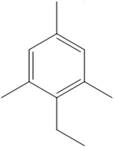
Explanation of Solution
The given reaction is Friedal Craft’s alkylation reaction. In the first step,
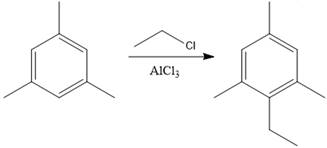
With the help of mechanism of electrophilic aromatic substitution reaction, the product of the given Friedel-Craft’s alkylation reaction was determined.
(b)
Interpretation:
In the given reaction, the aromatic ring has just one chemically distinct, aromatic H, so a single electrophilic aromatic substitution will lead to just a single product. The product of the given reaction is to be determined.
Concept introduction:
Electrophiles in electrophilic aromatic substation reactions typically must be generated in situ from more stable precursors that can be added as starting materials. Aluminum chloride acts as a Lewis acid and forms a complex with chlorine. After heterolysis, electrophilic aromatic substitution reaction takes place. The arenium ion intermediate is a carbocation intermediate consisting of five
Answer to Problem 22.26P
The product of the given halogenation reaction is as shown:

Explanation of Solution
The given reaction is Friedal Craft’s alkylation reaction. In the first step
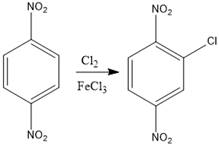
With the help of mechanism of electrophilic aromatic substitution reaction, the product of the given reaction was determined.
(c)
Interpretation:
In the given reaction, the aromatic ring has just one chemically distinct, aromatic H, so a single electrophilic aromatic substitution will lead to a just a single product. The product of the given reaction is to be determined.
Concept introduction:
In Friedel Craft’s acylation reaction, the aromatic species is treated with acyl chloride. The product of Friedel Craft’s acylation reaction is
Answer to Problem 22.26P
The product of the given Friedel-Craft’s acylation reaction is as shown.
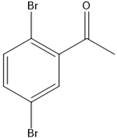
Explanation of Solution
The given reaction is Friedal Craft’s acylation reaction. In the first step,
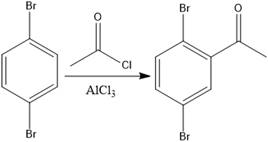
With the help of the mechanism of electrophilic aromatic substitution reaction, the product of the given Friedel-Craft’s acylation reaction was determined.
Want to see more full solutions like this?
Chapter 22 Solutions
Organic Chemistry: Principles And Mechanisms: Study Guide/solutions Manual (second)
- 3) Propagation of uncertainty. Every measurement has uncertainty. In this problem, we'll evaluate the uncertainty in every step of a titration of potassium hydrogen phthalate (a common acid used in titrations, abbreviated KHP, formula CsH5KO4) with NaOH of an unknown concentration. The calculation that ultimately needs to be carried out is: concentration NaOH 1000 x mass KHP × purity KHP molar mass KHP x volume NaOH Measurements: a) You use a balance to weigh 0.3992 g of KHP. The uncertainty is ±0.15 mg (0.00015 g). b) You use a buret to slowly add NaOH to the KHP until it reaches the endpoint. It takes 18.73 mL of NaOH. The uncertainty of the burst is 0.03 mL.. c) The manufacturer states the purity of KHP is 100%±0.05%. d) Even though we don't think much about them, molar masses have uncertainty as well. The uncertainty comes from the distribution of isotopes, rather than random measurement error. The uncertainty in the elements composing KHP are: a. Carbon: b. Hydrogen: ±0.0008…arrow_forwardDon't used hand raiting and don't used Ai solutionarrow_forwardHow would you use infrared spectroscopy to distinguish between the following pairs of constitutional isomers? (a) CH3C=CCH3 || and CH3CH2C=CH (b) CH3CCH=CHCH3 and CH3CCH2CH=CH2 Problem 12-41 The mass spectrum (a) and the infrared spectrum (b) of an unknown hydrocarbon are shown. Propose as many structures as you can. (a) 100 Relative abundance (%) 80 60 60 40 200 20 (b) 100 Transmittance (%) 10 20 20 80- 60- 40- 20 40 60 80 100 120 140 m/z 500 4000 3500 3000 2500 2000 1500 Wavenumber (cm-1) 1000arrow_forward
- Propagation of uncertainty. You have a stock solution certified by the manufacturer to contain 150.0±0.03 µg SO42-/mL. You would like to dilute it by a factor of 100 to obtain 1.500 µg/mL. Calculate the uncertainty in the two methods of dilution below. Use the following uncertainty values for glassware: Glassware Uncertainty (assume glassware has been calibrated and treat the values below as random error) 1.00 mL volumetric pipet 0.01 mL 10.00 mL volumetric pipet 0.02 mL 100.00 mL volumetric flask 0.08 mL Transfer 10.00 mL with a volumetric pipet and dilute it to 100 mL with a volumetric flask. Then take 10.00 mL of the resulting solution and dilute it a second time with a 100 mL flask. 2. Transfer 1.00 mL with a volumetric pipet and dilute it to 100 mL with a volumetric flask.arrow_forwardDraw all resonance structures for the following ion: CH₂ Draw all resonance structures on the canvas by choosing buttons from the Tools (for bonds), Atoms, and Advanced Template toolbars, including charges where needed. The single bond is active by default. 2D ד CONT HD EXP CON ? 1 [1] Α 12 Marvin JS by Chemaxon A DOO H C N Br I UZ OSPFarrow_forwardWhat is the average mass of the 10 pennies? Report your value with correct significant figures. What is the error (uncertainty) associated with each mass measurement due to the equipment? What is the uncertainty associated with the average value? Note that the uncertainty of the balance will propagate throughout the calculation. What is the standard deviation of the 10 mass measurements? Explain the difference between the propagated uncertainty and the standard deviation. Which number would you use to describe the uncertainty in the measurement? Calculate the total mass of the pennies with associated uncertainty. Calculate the average density of a penny based on these data. Propagate the uncertainty values for both mass and volume in your calculations.arrow_forward
- Can you help me and explain the answers please.arrow_forwardB 1 of 2 Additional problems in preparation to Midterm #1: 1.) How can the following compounds be prepared using Diels-Alder reaction: CH3 O CN (a) (b) CN CH3 2.) What is the missing reagent in the shown reaction? H3C + ? H3C H3C CN H3C ''CN (၁) H 3.) Write the products 1,2-addition and 1,4-addition of DBr to 1,3-cyclohexadiene. Remember, D is deuterium, a heavy isotope of hydrogen. It reacts exactly like hydrogen. 4.) In the shown reaction, which will be the kinetic product and which will be the thermodynamic product? H3C CI H3C HCI H3C + 5.) Which of the following molecules is aromatic? (a) (b) (c) H 6.) Which of the following molecules is aromatic? (a) (b) (c) 7.) Write the mechanism for the shown reaction. + Ха AICI 3 CI 8.) Suggest reagents that would convert benzene into the shown compounds. CI NO2 -8-6-6-8-a (a) (b) (c) (d) (e) (a) SO3H Brarrow_forwardThe number of 2sp^2 hybridized atoms in is: A. 8; B. 6; C.4; D.2; E.0;arrow_forward
 ChemistryChemistryISBN:9781305957404Author:Steven S. Zumdahl, Susan A. Zumdahl, Donald J. DeCostePublisher:Cengage Learning
ChemistryChemistryISBN:9781305957404Author:Steven S. Zumdahl, Susan A. Zumdahl, Donald J. DeCostePublisher:Cengage Learning ChemistryChemistryISBN:9781259911156Author:Raymond Chang Dr., Jason Overby ProfessorPublisher:McGraw-Hill Education
ChemistryChemistryISBN:9781259911156Author:Raymond Chang Dr., Jason Overby ProfessorPublisher:McGraw-Hill Education Principles of Instrumental AnalysisChemistryISBN:9781305577213Author:Douglas A. Skoog, F. James Holler, Stanley R. CrouchPublisher:Cengage Learning
Principles of Instrumental AnalysisChemistryISBN:9781305577213Author:Douglas A. Skoog, F. James Holler, Stanley R. CrouchPublisher:Cengage Learning Organic ChemistryChemistryISBN:9780078021558Author:Janice Gorzynski Smith Dr.Publisher:McGraw-Hill Education
Organic ChemistryChemistryISBN:9780078021558Author:Janice Gorzynski Smith Dr.Publisher:McGraw-Hill Education Chemistry: Principles and ReactionsChemistryISBN:9781305079373Author:William L. Masterton, Cecile N. HurleyPublisher:Cengage Learning
Chemistry: Principles and ReactionsChemistryISBN:9781305079373Author:William L. Masterton, Cecile N. HurleyPublisher:Cengage Learning Elementary Principles of Chemical Processes, Bind...ChemistryISBN:9781118431221Author:Richard M. Felder, Ronald W. Rousseau, Lisa G. BullardPublisher:WILEY
Elementary Principles of Chemical Processes, Bind...ChemistryISBN:9781118431221Author:Richard M. Felder, Ronald W. Rousseau, Lisa G. BullardPublisher:WILEY





